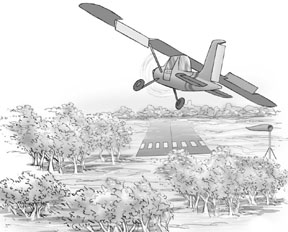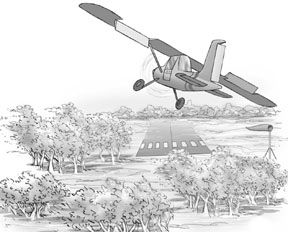
By Ray Leis
As the spring and summer flying season return, many general aviation pilots are realizing they havent flown much during the winter. As a result, they usually have lost some of the skills honed during the previous years flying season.
Up to a point, crosswind landings can be challenging and fun. But landing can become hard work when the the wind howls, gusts and bounces you and your passengers around. Still, a successful outcome depends on you, the pilot. One of those skills-especially useful during the spring-is handling a crosswind while landing. Pilots should be thoroughly familiar with all methods for dealing with a crosswind-the slip, the crab and the slip/crab combination-and, even if you have been trained to use one method, there are times when another may be very useful. But, regardless of the crosswind approach method you use, several traps exist to trip up the unwary, or the unprepared.
1. Use Flaps, Or Not?
Owners Manuals, Pilots Operating Handbooks, Airplane Flight Manuals and other publications contain basic and confusing information about using flaps during a crosswind landing. Youll find that one manufacturer may recommend partial flaps for a crosswind landing, while another may recommend a minimum flap settingconsistent with conditions like the runways length. Still other airframers deal themselves out of the game; they make no recommendations at all. Its as if crosswinds dont exist for their airplanes.
The FAA has certification rules requiring that an airplane must be controllable in a 90-degree crosswind at a velocity of 0.2 x Vso. Of course, Vso is the airplanes stall speed in the landing configuration, so, if Vso is 50 knots, 50 x 0.2 = 10 knots. In this case, the airplane must be controllable in a 90-degree, 10-knot crosswind. In other words, if your airplane stalls at 50 knots in its landing configuration (i.e., with full flaps), a direct 10-knot crosswind shouldnt bother it.
On the other hand, if the crosswind velocity exceeds 0.2 x Vso, youre not necessarily in test-pilot territory, but you must understand that control authority may be limited-you could run out of rudder or aileron at the wrong time.
The lower landing speed and shorter ground roll available when using flaps results in less wear and tear on the brakes and tires. But you still have to ensure effective directional control of the airplane is maintained at the slower speeds. This is when knowing the airplane and understanding what a direct crosswind at 20 knots with gusts to 30 actually means.
2. The Balloon
Ballooning-whether caused by over-control or by mistakes in judging the descent rate-can occur even in calm-wind landings. It can happen as a result of pitching up too enthusiastically in the round-out maneuver or as a result of establishing a too-steep pitch attitude in the flare. In a no-crosswind situation, it usually means you are carrying too much airspeed into the flare and have pitched the airplane to its landing attitude before any excess lift has been bled off. The unwanted altitude that you gain at the wrong time as a result of ballooning will depend largely on the airspeed and/or how rapidly the pitch attitude is increased.
Ballooned landings come in two types. One is the plain, steady-wind variety, where your height above the runway is increasing, and the airplane may be close to stalling out. Recovery from this is just as you practiced during your primary training: Add a touch of power, lower the nose slightly to stop the airspeed decay and then use coordinated pitch and power inputs to establish the proper flare attitude and gently descend to the runway.Improper recovery from a ballooned landing can result in touching down first on the nosewheel. And thats bad.
The serious variety of ballooning doesnt involve just your height above the runway, the power setting or the airplanes pitch attitude. Instead, with a gusty crosswind, you can also lose directional control at the same time the positive pitch attitude and decaying airspeed rob you of control authority.If you lose your crosswind correction in the confusion, annoyance and distraction of the moment, you are in a serious balloon and the outcome is rarely a good one.
The best solution in this situation is to get the heck out of there:Smoothly add full power while reestablishing or maintaining whats left of your directional control. Establish a pitch attitude that keeps the wheels off the runway and allows the airplane to accelerate while getting back your directional control. Go around, remembering that a full-flap configuration will result in higher pitch forces than you may be used to. For the next landing, remember what you did wrong, especially when it comes to an over-enthusiastic flare and airspeed control.
3. The Bounce
Weve all bounced a landing or two. In a crosswind situation, however, the bounced landing can be both more likely and more dangerous. This is because of the greater potential for loss of directional control at low airspeds and high angles of attack with a crosswind.
A bounced landing can result when the flare is made too slowly in a tricycle-gear airplane or too late in a conventional-gear airplane. Whatever you are flying, hit the runway hard enough and you will bounce. The force with which the aircraft strikes the runway (and how the pilot used the elevators at that instant) will depend on how high you will bounce. Again, the severity of a bounced landing in a crosswind situation depends not on how high you rebounded but on whether you have lost your crosswind correction.
The corrective action for a bounce depends on how severe it is. Its the same corrective action for ballooning: Add some power and control the pitch to establish the proper flare attitude. One rule to paste up on the panel-anytime you experience an excessive bounce or balloon (10 feet is excessive), apply power and execute a go-around.
Many landing accidents result from the pilots failure to react effectively to a balloon or a bounce. It is possible to recover from a bounced landing by applying power and easing the airplane to the ground.There are some highly proficient pilots who can get away with it, consistently. If youre not that experienced, you better take the airplane around, and think about how to correct your technique on the next landing.
If you use engine power during a balloon or bounce, the airplanes nose should never be pointed down any lower than a level pitch attitude.
4. Landing Attitude
What is the landing attitude in the airplane that you fly? The easiest way to understand the landing attitude for your airplane is to practice some slow flight-flying level, at minimum controllable airspeed, in the landing configuration. This slow flight attitude is usually close to the level pitch attitude in most airplanes, lower than the landing attitude.
How does this relate to a crosswind landing? In two ways. First, if the pitch attitude is greater than the landing attitude, the resulting airspeed decay will mean more difficulty in maintaining directional control. Second, and presuming there is adequate runway in front of you, a shallower pitch attitude than normal is appropriate, along with a bit more power than normal.As a result, youll probably be carrying slightly more airspeed into the flare and, to prevent ballooning, will want to pitch up more gently and not increase the pitch attitude to as high an angle of attack as you would without a crosswind.
The idea is to gently fly the airplane onto the runway, all the while maintaining directional control and the proper pitch attitude, so that ground steering can take over from the flight controls at the moment the airplane stops flying. A lot of precious runway can be used up, however, so the runway must be adequate-long enough and wide enough-considering the crosswind.
Learning the proper landing attitude for landings with and without crosswinds is where you can get some extra value out of your flight review.Or, if thats too far off, and you are a bit rusty on slow flight, get with your local CFI.
5. The Porpoise
In any landing-with or without a crosswind-porpoising can result in a violent, unstable condition, where the aircraft bounces back and forth between the nosewheel (or tailwheel) and the main gear after initial touchdown. Too often, a bent airplane is the result, either from placing too much energy on a relatively fragile nosewheel or from the inevitable loss of directional control and the short but exciting trip off the runway.
What causes porpoising? What usually happens is that the pilot attempts to recover from a bounce with opposite control movement. Wrong move. The airplane and the pilots reaction time wont mesh, getting the airplane into pilot-induced oscillation, and the porpoising will be aggravated. Repeated heavy impacts of the aircraft and the ground, during the porpoising, can result in structural damage to the airframe and the landing gear.
What can a pilot do, once the porpoising starts? First, immediately and smoothly establish the normal landing attitude. Maintain this attitude and add power. The power will get back flying speed and control effectiveness, allowing the aircraft to get airborne again, eliminating further bouncing on the runway. Once out of the porpoise condition, the pilot needs to decide if there is enough runway left for a normal landing, or to go around.
Conclusion
By now, youve noticed there is one solution to many of these crosswind traps-the go-around. The decision to go around or not to go around is one of a pilots most critical airborne decisions. It generally isnt a major issue during an approach, unless you discover an unexpected obstacle on the runway or, in the case of a crosswind, discover you cant maintain directional control because the wind is too strong, the airplane is too slow or the runway is too narrow. The go-around will be tougher if it has to be executed from the flare. The trick is to recognize a poor landing early, with adequate energy and altitude. Its a lot safer and easier than allowing a situation to develop that can get out of control.
Also With This Article
“Crosswind Checklist”
“Max Crosswind Component?”
“The Stabilized Approach”
-Ray Leis holds ATP, CFII, Commercial and glider certifcates, and has been a Designated Pilot Examiner.




